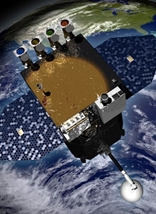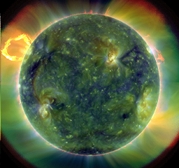 |
 |
| Atmospheric Imaging Assembly (AIA) at SAO | ||||
|
The Atmospheric Imaging Assembly (AIA) is a four-telescope array, operating primarily in the extreme ultraviolet (EUV), aboard NASA's Solar Dynamics Observatory (SDO) - the current flagship of the Living With a Star program. AIA is a coordinated effort led by the Lockheed Martin Solar and Astrophysics Laboratory (LMSAL) with the Smithsonian Astrophysical Observatory (SAO) as the major subcontractor, responsible for building the telescope assemblies and for assistance with calibration, data handling, and interpretation. CCD cameras for the AIA telescopes have been provided by MSSL, RAL, and E2V. AIA provides an unprecedented view of the solar corona, which has been found to be highly variable and highly structured in space, time, and temperature. The corona is dominated by the emerging and evolving surface magnetic fields of the Sun, leading to large-scale structuring along the magnetic field and short-scales in the perpendicular direction, with variability on time scales ranging from a second or less to weeks and months. Understanding coronal dynamics requires observation in all of these dimensions and on all of these scales, and SDO is taking a major step in that direction. The multiple channels of the AIA provide full disk observations at photopsheric to coronal flaring temperatures, with high spatial and temporal resolution. Researchers at SAO are currently using AIA to shed new light into a variety of areas. Among them are the nature of solar flares and coronal mass ejections (CMEs), whose thermal structuring can now be directly imaged over an unprecedented range of temperatures. The exquisite resolution and 12 second time cadence of AIA also allows for a refined examination of coronal waves, granting new insights into their underlying physical mechanisms. New tests for mathematical models are also being provided by the heightened detail, and already the fine structure revealed by AIA has helped physicists refine their models for coronal heating (something still not well-understood) and for how events like flares, CMEs, and filament eruptions occur and develop, bringing scientists ever closer to successful forecasting of solar events. For more information on the types of research being done at SAO using AIA, follow the "Recent Publications" link in the left navigation bar. And for more extensive information on AIA, visit the main AIA page hosted by LMSAL. |
Multi-channel AIA composite. Reds are comparatively cool, while greens and blues trace higher temperature material. | |||

|
|



